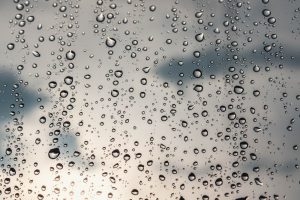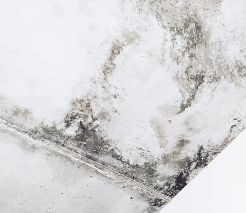CAUSES & EFFECTS OF CONDENSATION IN BUILDINGS

Condensation is simple physics: Warm moisture-laden air always moves form warm to cold, high pressure to low, wet to dry. Condensation is caused whenever air, which contains a substantial amount of moisture meets a solid (or low perm) surface that is below the dew point or temperature of air. Condensation does not, except in the most exceptional circumstances, occur continuously, but varies with temperature, air movement (pressures) and relative humidity.
Condensation and Mold Growth

Condensation is directly associated with mold growth. Mold simply requires airborne dirt, and water to grow (just like grass). It is by far the most common cause of unwanted mold in buildings, probably accounting for the majority of water damage problems. It affects both old and new buildings alike. It can mask itself as water leaks from roofs, rain penetration through walls, etc. The problem is not always initially obvious.
Typical High Moisture Causes in Buildings:
Moisture added to the air within the building due to the activities or processes that increase humidity levels inside that raise the dew point to a higher temperature.
- Moisture added to the air by wicking through concrete floors (from the ground) that do not have vapor barriers installed underneath them.
- Mechanical systems that pressurize certain parts of buildings and exit at specific, cold locations (i.e. chimneys, vent stacks, exhaust shutters, exhaust fans, electrical wire chases, air leaking through windows and doors, etc.).
- Water can be brought into the building by cold, absorbent materials (snow, pallets, cardboard, vehicles, etc.), which give off moisture to the warm air (even though they appear dry) when brought in from the outside.
- Another source is most common in the late evening when most of the water making activities (showers, washing machines, humidifiers, people and pets breathing) have ended and the air inside begins cooling causing it to shed moisture. When this happens regularly, the consequent accumulation of water can make the surfaces wet. If the wet surfaces are below freezing, ice builds up.
- If internal ventilation is inadequate, then the moisture will remain in the air and re-appear when cooling of the building takes place.
Tools for Recognizing Hidden Condensation:
Infra-red Cameras, Non-destructive moisture meters, Moisture Detection Paper, or the old fashioned way, tear it open.
Condensation is typically a seasonal problem occurring during the colder months of October to April. During the summer, the problem may go away. During the winter, ventilation of the structure is typically low because windows and doors are closed, cold air drafts stopped, etc. The resulting build-up of water vapor in the building can be sufficient to cause condensation. The problem can occur far away from the site of most water vapor production. e.g. water vapor produced in the offices may diffuse through the building and travel into a cooler production room where it will condense on a cold surface.
Obvious signs are apparent given some the following symptoms:
- Water droplets (fog or frost) form on cold, hydrophobic surfaces such as glass and paint.
- Slightly damp wallpaper (often not noticed).
- Development of molds, including black mold.
- Shadow lines on the interior or exterior where structural members (stud or rafters) are located.
Condensation may be long term, but it is often intermittent, forming only at certain times of the day or night. In many cases, the only sign of condensation may be mold growth, as any moisture may have evaporated by the time moisture measurements are taken.
The Solution(s):
The control of condensation is based on two very simple primary measures and where necessary supported by one or more secondary measures.
- Primary Measure 1 – Improve Ventilation This will sweep away the internal moisture-laden air and replace it with drier air from the outside. Yes, external air is drier than internal air most of the year! Poor indoor air quality leads to; Condensation through increasing humidity levels often in association with the progressive sealing of buildings to save energy.
- Primary Measure 2 – Improve Heating Coupled with ventilation, heating should be set or applied to give a low-level background heat. This will ensure no rapid temperature changes to the environment and will cause a slight warming of cold surfaces thus reducing the risk of condensation.
Secondary Measures:
- Remove excess water sources: This means removing systems within the structure that generate excess water vapor. e.g. propane or natural gas radiant heaters generate enormous amounts of water vapor. These alone may be responsible for the condensation.
- Insulate Cold Surfaces: Consideration should be given to cold surfaces where possible (some building materials have better thermal properties than others).
- Provide a vapor barrier on the warm side (in Winter), of the insulation to prevent problems within walls and roofs.
- Prevent possible Water Penetration (treating surfaces like masonry with a silicone water-repellent can help in some cases. This prevents water penetration, thus maintaining better thermal properties of external walls and roofs.
The field of condensation diagnosis often proves frustrating, costly, and difficult due the myriad of causes and sometimes requires much problem-solving.
Conclusion:
Building use, pressures, temperatures, relative humidity, and weather cycles should be seriously considered during the design process as they can represent monumental costs in the future performance of the structure.
Article by Steve Eddy & Associates
Steve Eddy is a recognized leader in the spray foam, polyurea and coating industries.
For more information on this article, or other building science issues,
contact: Steven R. Eddy at 616-514-8359 or at Email: s.eddy@att.net
Jay Davidson, Editor Spray Foam Insider





